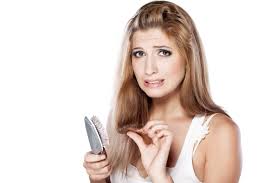OTHER CAUSES THAT INFLUENCE HAIR LOSS
- SEASONS: in spring and autumn hair loss is more common.
- CONTRACEPTIVES: hair loss can be accelerated by the effects of the male hormone that some contraceptives contain.
- LACK OF IRON: is another cause of hair loss. In women this problem is more common, especially if they have long or heavy periods.
- DIET: vegetarians, people who have a low intake of protein diet and patients with anorexia nervosa may have poor protein nutrition. As a result, about three months later there is a massive hair loss.
- POSTPARTUM: after delivery, some hairs may enter the resting phase of hair growth cycle and begin to fall out.
- STRESS AND DISEASE: you can start losing hair after a stressful situation. High fever, severe infections or chronic diseases can also cause hair loss.
- MEDICATIONS: some drugs used in chemotherapy cause hair cells to stop dividing. They can lose up to 90% of the hair, but in most cases it grows when treatment ends.
Summer and its effects on the hair
UV rays, salt, chlorine, sand ... along with hair dryers, irons, dyes, chemicals ... ->Damage the hair fiber:
- Dryness.
- Dehydration.
- Breakage.
HAIR LOSS COMPLETE TREATMENT
SHOCK TREATMENT (3 months)
Anti Hair Loss Lotion, 3 times / week nights.
Anti Hair Loss Ampoules, 3 times / week nights
Anti Hair Loss Shampoo, 3 times /week the day after applying Anti Hair Loss Lotion and Anti Hair Loss Ampoules.
Frequency Shampoo, 4 times /week the days that the treatment is not done.
Seskavel plus capsules (2 capsules / day).
MAINTENANCE THERAPY
Anti Hair Loss Lotion, 3 times / week nights.
Anti Hair Loss Ampoules, 3 times / week nights.
Anti Hair Loss Shampoo, 1-2 times/week.
Frequency Shampoo the rest of the days.
Kavel M cápsulas (2 capsules/ day / 2 times per week).
How to use
Shock Treatment: Apply every day for the first 3 months: 1. Evening: Seskavel Ampules + SeskavelAnti hair loss lotion 2. By day: Wash hair with Seskavel anti hair loss shampoo.
Maintenance treatment: Apply every day, from the treatment of shock: 1. Evening: Seskavel anti hair loss lotion except two times a week, on which you will apply Seskavel ampules 2. By day: Wash hair with Seskavel Anti hair loss shampoo.
Apply the contents of the vial directly on the scalp performing a gentle massage with fingertips. When the hair is dry, apply a few drops of Seskavel anti hair lotion on the scalp and give a gentle massage with fingertips. Do not rinse. The daily dose is 2 ml equivalent to 12 sprays.

 Österreich
Österreich  Bolivia
Bolivia  Brasil
Brasil  България
България  China
China  China - Hong Kong
China - Hong Kong  Colombia
Colombia  Costa Rica
Costa Rica  Česká republika
Česká republika  Dominicana
Dominicana  USA
USA  El Salvador
El Salvador  France
France  Deutschland
Deutschland  Guatemala
Guatemala  India
India  Éire
Éire  Italia
Italia  Lëtzebuerg
Lëtzebuerg  Malta
Malta  المغرب
المغرب  Mexico
Mexico  Nederland
Nederland  Panama
Panama  Peru
Peru  Polska
Polska  Portugal
Portugal  România
România  Россия
Россия  España
España  China - 台湾
China - 台湾  الجمهورية التونسية
الجمهورية التونسية  Türkiye
Türkiye  United kingdom
United kingdom  International
International 










